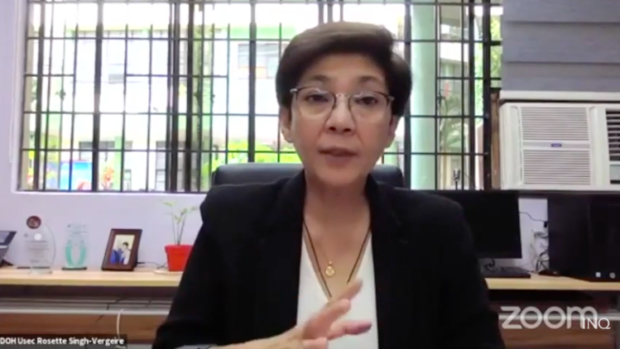DOH clarifies: No increase in number of severe, critical cases of COVID-19

FILE PHOTO Health Undersecretary Maria Rosario Vergeire explains a point during the DOH press briefing. Screengrab from livestream
MANILA, Philippines — The Department of Health (DOH) clarified on Thursday that the increase in the percentage of severe and critical cases of COVID-19 in its daily reports is just a result of delayed validation on the status of these cases and of the lower number of active infections.
Based on the DOH’s bulletin on November 1, there were only 7.2 percent severe cases and 3 percent critical cases out of 43,185 active coronavirus infections in the country. But as of November 24, the number of severe cases increased to 14.4 percent and critical patients rose to six percent out of 17,864 total active infections.
Health Undersecretary Maria Rosario Vergeire, however, notes that this is not the situation on the ground.
“Let me clarify this. Unang una, wala pong pagtaas ng severe and critical cases among our monitoring of different hospitals in the country. What is happening is because bumababa po ang ating active cases so definitely, it’s a function of the number, tumataas ang porsyento ng mga severe and critical dahil nga po lumiit na ang ating denominator,” she told an online media briefing.
(Let me clarify this. First, there is no increase in the number of severe and critical cases based on our monitoring in different hospitals in the country. What is happening is because the number of active cases is decreasing so definitely it’s a function of the number. The percentage of severe and critical cases increases because the denominator decreases.)
According to Vergeire, severe and critical patients are also not included in the time-based tagging of cases.
Under the time-based tagging system, mild, asymptomatic, and moderate cases of COVID-19 are automatically tagged as recovered when they reach the 14th day of quarantine.
The time-based tagging of recoveries was done weekly since August last year but was made daily starting April this year. The DOH opted to implement this system because it takes a long time for local government units to validate if a patient has already recovered, thus resulting in a higher number of active cases in the tally.
Vergeire said this is also the reason why the DOH’s daily case bulletin also mentions the number of recoveries that were later validated as deaths.
“Dito sa ating ginawang proseso na ito, hindi natin naiisama ang severe and critical because we wanted to make sure na ‘yung hospital ang magsasabi sa atin na they have already recovered,” the health official explained.
(In this process, we are not including the severe and critical cases because we wanted to make sure that hospitals will be the ones to declare the recovery of these patients.)
“Naiiwan po sila doon sa database, when in fact when we started validating from the DOH’s side, nakita namin na marami na dito sa mga taong ito, recovered na pala, hindi pa lang nasasubmit ang report,” she added.
(They are left behind in the database when in fact when we validated it, many of these people have already recovered, and that reports on their status were just not submitted yet.)
According to Vergeire, the DOH is already coordinating with local government units to fast-track the validation of status for severe and critical cases.
“This is a function of reporting naman. So again let me just reiterate and clarify, wala pong pagtaas ng severe and critical cases among hospital admissions dito sa ating bansa,” she said.
(This is just a function of reporting. So again let me reiterate and clarify that there is no increase in severe and critical cases among hospital admissions in the country.)
JPV
For more news about the novel coronavirus click here.
What you need to know about Coronavirus.
For more information on COVID-19, call the DOH Hotline: (02) 86517800 local 1149/1150.
The Inquirer Foundation supports our healthcare frontliners and is still accepting cash donations to be deposited at Banco de Oro (BDO) current account #007960018860 or donate through PayMaya using this link.


















